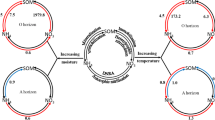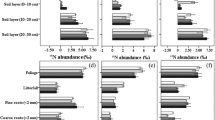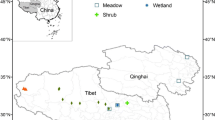Abstract
Soil soluble nitrogen (N) is crucial to the N nutrition and productivity of plants. Consequently, understanding the factors that affect its pool size and composition is of considerable importance. Here, six typical forest types in northeast China were investigated to determine the dynamics of soil soluble N across seasons and plant communities, and the potential drivers. Soil free amino acids, NH4+, NO3−, dissolved organic N (DON) and a variety of soil characteristics were measured over the growing season (from May to September). Seasonality showed a stronger effect on the availability of soil inorganic N and free amino acids than vegetation. The coefficients of variation of soil inorganic N, amino acid-N and the potential drivers (moisture and DON) appeared to be greater for season, and the concentrations of these available N sources tended to be higher at the beginning than at the height of growing season. Potential soil drivers (e.g. moisture, microbial biomass-N and DON) and plant phenology together drove the seasonal dynamics of inorganic N and amino acid-N. Arginine, histidine, serine, leucine, aspartic acid, glycine, glutamic acid and proline composed the dominant soil amino acid pool in the temperate forest soils. The basic amino acids (arginine and histidine) were consistently dominant irrespective of vegetation and season, suggesting that selective sorption by the soil solid phase could play an important role in regulating the cycling of amino acid-N in these temperate forest ecosystems. This research indicates that changes in local soil properties, and plant phenology caused by seasonality, exert a powerful influence on the characteristics of plant-soil N cycling.






Similar content being viewed by others
References
Bardgett RD, Wal RVD, Jónsdóttir IRS, Quirk H, Dutton S (2007) Temporal variability in plant and soil nitrogen pools in a high-Arctic ecosystem. Soil Biol Biochem 39:2129–2137. https://doi.org/10.1016/j.soilbio.2007.03.016
Björk RG, Klemedtsson L, Molau U, Harndorf J, Ödman A, Giesler R (2007) Linkages between N turnover and plant community structure in a tundra landscape. Plant Soil 294:247–261. https://doi.org/10.1007/s11104-007-9250-4
Bobbink R, Hicks K, Galloway J, Spranger T, Alkemade R, Ashmore M, Bustamante M, Cinderby S, Davidson E, Dentener F (2010) Global assessment of nitrogen deposition effects on terrestrial plant diversity: a synthesis. Ecol Appl 20:30–59. https://doi.org/10.1890/08-1140.1
Brookes PC, Landman A, Pruden G, Jenkinson DS (1985) Chloroform fumigation and the release of soil nitrogen: a rapid direct extraction method to measure microbial biomass nitrogen in soil. Soil Biol Biochem 17:837–842. https://doi.org/10.1016/0038-0717(85)90144-0
Chapin FS III, Moilanen L, Kielland K (1993) Preferential use of organic nitrogen for growth by a non-mycorrhizal arctic sedge. Nature 361:150–153. https://doi.org/10.1038/361150a0
D’Odorico P, Caylor K, Okin GS, Scanlon TM (2007) On soil moisture–vegetation feedbacks and their possible effects on the dynamics of dryland ecosystems. J Geophys Res-BioBgeo 112:G04010. https://doi.org/10.1029/2006JG000379
Darrouzet-Nardi A, Weintraub MN (2014) Evidence for spatially inaccessible labile N from a comparison of soil core extractions and soil pore water lysimetry. Soil Biol Biochem 73:22–32. https://doi.org/10.1016/j.soilbio.2014.02.010
Edwards KA, Mcculloch J, Kershaw GP, Jefferies RL (2006) Soil microbial and nutrient dynamics in a wet Arctic sedge meadow in late winter and early spring. Soil Biol Biochem 38:2843–2851. https://doi.org/10.1016/j.soilbio.2006.04.042
Endres L, Mercier H (2003) Amino acid uptake and profile in bromeliads with different habits cultivated in vitro. Plant Physiol Bioch 41:181–187. https://doi.org/10.1016/S0981-9428(02)00025-6
Fischer H, Meyer A, Fischer K, Kuzyakov Y (2007) Carbohydrate and amino acid composition of dissolved organic matter leached from soil. Soil Biol Biochem 39:2926–2935. https://doi.org/10.1016/j.soilbio.2007.06.014
Gao L, Cui X, Hill PW, Guo Y (2019) Uptake of various nitrogen forms by co-existing plant species in temperate and cold-temperate forests in northeast China. Appl Soil Ecol 147:103398. https://doi.org/10.1016/j.apsoil.2019.103398
Gonod LV, Jones DL, Chenu C (2006) Sorption regulates the fate of the amino acids lysine and leucine in soil aggregates. Eur J Soil Sci 57:320–329. https://doi.org/10.1111/j.1365-2389.2005.00744.x
Grogan P, Michelsen A, Ambus P, Jonasson S (2004) Freeze–thaw regime effects on carbon and nitrogen dynamics in sub-Arctic heath tundra mesocosms. Soil Biol Biochem 36:641–654. https://doi.org/10.1016/j.soilbio.2003.12.007
Hackl E, Bachmann G, Zechmeister-Boltenstern S (2004) Microbial nitrogen turnover in soils under different types of natural forest. Forest Ecol Manag 188:101–112. https://doi.org/10.1016/j.foreco.2003.07.014
Harrison KA, Bol R, Bardgett RD (2007) Preferences for different nitrogen forms by coexisting plant species and soil microbes. Ecology 88:989–999. https://doi.org/10.1890/06-1018
Hicks RE, Lee C, Marinucci AC (1991) Loss and recycling of amino acids and protein from smooth cordgrass (Spartina alterniflora) litter. Estuar Coast 14:430–439. https://doi.org/10.2307/1352267
Hill PW, Farrar J, Roberts P, Farrell M, Grant H, Newsham KK, Hopkins DW, Bardgett RD, Jones DL (2011) Vascular plant success in a warming Antarctic may be due to efficient nitrogen acquisition. Nat Clim Change 8:613–619. https://doi.org/10.1038/nclimate1060
Hill EJ, Jones DL, Paterson E, Hill PW (2019a) Hotspots and hot moments of amino acid N in soil: real-time insights using continuous microdialysis sampling. Soil Biol Biochem 131:40–43. https://doi.org/10.1016/j.soilbio.2018.12.026
Hill PW, Broughton R, Bougoure J, Havelange W, Newsham KK, Grant H, Murphy DV, Clode P, Ramayah S, Marsden KA, Quilliam RS, Roberts P, Brown C, Read DJ, Deluca TH, Bardgett RD, Hopkins DW, Jones DL (2019b) Angiosperm symbioses with non-mycorrhizal fungal partners enhance N acquisition from ancient organic matter in a warming maritime Antarctic. Ecol Lett 22:2111–2119. https://doi.org/10.1111/ele.13399
Hobbie JE, Hobbie EA (2013) Microbes in nature are limited by carbon and energy: the starving-survival lifestyle in soil and consequences for estimating microbial rates. Front Microbiol 4:87–100. https://doi.org/10.1016/j.soilbio.2015.07.021
Jan M, Roberts P, Tonheim S, Jones D (2009) Protein breakdown represents a major bottleneck in nitrogen cycling in grassland soils. Soil Biol Biochem 41:2272–2282. https://doi.org/10.1016/j.soilbio.2009.08.013
Jones D, Darrah P (1994) Amino-acid influx at the soil-root interface of Zea mays L. and its implications in the rhizosphere. Plant Soil 163:1–12. https://doi.org/10.1007/BF00033935
Jones DL, Kielland K (2002) Soil amino acid turnover dominates the nitrogen flux in permafrost-dominated taiga forest soils. Soil Biol Biochem 34:209–219. https://doi.org/10.1016/S0038-0717(01)00175-4
Kahmen A, Renker C, Unsicker SB, Buchmann N (2006) Niche complementarity for nitrogen: an explanation for the biodiversity and ecosystem functioning relationship? Ecology 87:1244–1255. https://doi.org/10.1890/0012-9658(2006)87[1244:NCFNAE]2.0.CO;2
Kielland K, McFarland JW, Ruess RW, Olson K (2007) Rapid cycling of organic nitrogen in taiga forest ecosystems. Ecosystems 10:360–368. https://doi.org/10.1007/s10021-007-9037-8
Killham K (1990) Nitrification in coniferous forest soils. Plant Soil 128:31–44. https://doi.org/10.1007/BF00009394
Kraus TEC, Dahlgren RA, Zasoski RJ (2003) Tannins in nutrient dynamics of forest ecosystems—a review. Plant Soil 256:41–66. https://doi.org/10.1023/A:1026206511084
Kuzyakov Y, Xu X (2013) Competition between roots and microorganisms for nitrogen: mechanisms and ecological relevance. New Phytol 198:656–669. https://doi.org/10.1111/nph.12235
Kuzyakov Y, Hill PW, Jones DL (2007) Root exudate components change litter decomposition in a simulated rhizosphere depending on temperature. Plant Soil 290:293–305. https://doi.org/10.1007/s11104-006-9162-8
LeBauer DS, Treseder KK (2008) Nitrogen limitation of net primary productivity in terrestrial ecosystems is globally distributed. Ecology 89:371–379. https://doi.org/10.1890/06-2057.1
Lipson DA, Raab TK, Schmidt SK, Monson RK (1999a) Variation in competitive abilities of plants and microbes for specific amino acids. Biol Fert Soils 29:257–261. https://doi.org/10.1007/s003740050550
Lipson DA, Schmidt SK, Monson RK (1999b) Links between microbial population dynamics and nitrogen availability in an alpine ecosystem. Ecology 80:1623–1631. https://doi.org/10.1890/0012-9658(1999)080[1623:LBMPDA]2.0.CO;2
Liu HJ (1994) Determination of amino acids by precolumn derivatization with 6-aminoquinolyl-N-hydroxysuccinimidyl carbamate and high-performance liquid chromatography with ultraviolet detection. J Chromatogr A 670:59–66. https://doi.org/10.1016/0021-9673(94)80280-7
Liu X, Zhang Y, Han W, Tang A, Shen J, Cui Z, Vitousek P, Erisman JW, Goulding K, Christie P (2013) Enhanced nitrogen deposition over China. Nature 494:459–462. https://doi.org/10.1038/nature11917
Lützow M, Kögel-Knabner I, Ekschmitt K, Matzner E, Guggenberger G, Marschner B, Flessa H (2006) Stabilization of organic matter in temperate soils: mechanisms and their relevance under different soil conditions–a review. Eur J Soil Sci 57:426–445
McKane RB, Johnson LC, Shaver GR, Nadelhoffer KJ, Rastetter EB, Fry B, Giblin AE, Kielland K, Kwiatkowski BL, Laundre JA (2002) Resource-based niches provide a basis for plant species diversity and dominance in arctic tundra. Nature 415:68–71. https://doi.org/10.1038/415068a
Meier IC, Finzi AC, Phillips RP (2017) Root exudates increase N availability by stimulating microbial turnover of fast-cycling N pools. Soil Biol Biochem 106:119–128. https://doi.org/10.1016/j.soilbio.2016.12.004
Michalzik B, Matzner E (1999) Dynamics of dissolved organic nitrogen and carbon in a Central European Norway spruce ecosystem. Eur J Soil Sci 50:579–590. https://doi.org/10.1046/j.1365-2389.1999.00267.x
Millard P, Grelet G-a (2010) Nitrogen storage and remobilization by trees: ecophysiological relevance in a changing world. Tree Physiol 30:1083–1095. https://doi.org/10.1093/treephys/tpq042
Mopper K, Zika RG (1987) Free amino acids in marine rains: evidence for oxidation and potential role in nitrogen cycling. Nature 325:246–249. https://doi.org/10.1038/325246a0
Moreau D, Bardgett RD, Finlay RD, Jones DL, Philippot L (2019) A plant perspective on nitrogen cycling in the rhizosphere. Funct Ecol 33:540–552. https://doi.org/10.1111/1365-2435.13303
Näsholm T, Ekblad A, Nordin A, Giesler R, Högberg M, Högberg P (1998) Boreal forest plants take up organic nitrogen. Nature 392:914–916. https://doi.org/10.1038/31921
Näsholm T, Kielland K, Ganeteg U (2009) Uptake of organic nitrogen by plants. New Phytol 182:31–48. https://doi.org/10.1111/j.1469-8137.2008.02751.x
Ouyang S, Tian Y, Liu Q, Zhang L, Wang R, Xu X (2016) Nitrogen competition between three dominant plant species and microbes in a temperate grassland. Plant Soil 408:121–132. https://doi.org/10.1007/s11104-016-2904-3
Phillips RP, Erlitz Y, Bier R, Bernhardt ES (2008) New approach for capturing soluble root exudates in forest soils. Funct Ecol 22:990–999. https://doi.org/10.1111/j.1365-2435.2008.01495.x
Qi Y, Li F, Liu Z, Jin G (2014) Impact of understorey on overstorey leaf area index estimation from optical remote sensing in five forest types in northeastern China. Agr Forest Meteorol 198:72–80. https://doi.org/10.1016/j.agrformet.2014.08.001
Quan X, Wang C, Zhang Q, Wang X, Luo Y, Bond-Lamberty B (2010) Dynamics of fine roots in five Chinese temperate forests. J Plant Res 123:497–507. https://doi.org/10.1007/s10265-010-0322-9
Rajendran N, Kathiresan K (2000) Biochemical changes in decomposing leaves of mangroves. Chem Ecol 17:91–102. https://doi.org/10.1080/02757540008037664
Roberts P, Newsham KK, Bardgett RD, Farrar JF, Jones DL (2009) Vegetation cover regulates the quantity, quality and temporal dynamics of dissolved organic carbon and nitrogen in Antarctic soils. Polar Biol 32:999–1008. https://doi.org/10.1007/s00300-009-0599-0
Rothstein DE (2010) Effects of amino-acid chemistry and soil properties on the behavior of free amino acids in acidic forest soils. Soil Biol Biochem 42:1743–1750. https://doi.org/10.1016/j.soilbio.2010.06.011
Sanders-DeMott R, Sorensen PO, Reinmann AB, Templer PH (2018) Growing season warming and winter freeze–thaw cycles reduce root nitrogen uptake capacity and increase soil solution nitrogen in a northern forest ecosystem. Biogeochemistry 137:337–349. https://doi.org/10.1007/s10533-018-0422-5
Senwo ZN, Tabatabai MA (1998) Amino acid composition of soil organic matter. Biol Fert Soils 26:235–242. https://doi.org/10.1007/s003740050373
Stahl VM, Beyschlag W, Werner C (2011) Dynamic niche sharing in dry acidic grasslands-a 15N-labeling experiment. Plant Soil 344:389–400. https://doi.org/10.1007/s11104-011-0758-2
Stevens CJ, Duprè C, Dorland E, Gaudnik C, Gowing DJG, Bleeker A, Diekmann M, Alard D, Bobbink R, Fowler D (2010) Nitrogen deposition threatens species richness of grasslands across Europe. Environ Pollut 158:2940–2945. https://doi.org/10.1016/j.envpol.2010.06.006
Wang C, Yang J, Zhang Q (2006) Soil respiration in six temperate forests in China. Global Change Biol 12:2103–2114. https://doi.org/10.1111/j.1365-2486.2006.01234.x
Wang X, Fang J, Zhu B (2008) Forest biomass and root–shoot allocation in northeast China. Forest Ecol Manag 255:4007–4020. https://doi.org/10.1016/j.foreco.2008.03.055
Wang C, Han Y, Chen J, Wang X, Zhang Q, Bond-Lamberty B (2013) Seasonality of soil CO2 efflux in a temperate forest: Biophysical effects of snowpack and spring freeze–thaw cycles. Agr Forest Meteorol 177:83–92. https://doi.org/10.1016/j.agrformet.2013.04.008
Warren CR, Taranto MT (2010) Temporal variation in pools of amino acids, inorganic and microbial N in a temperate grassland soil. Soil Biol Biochem 42:353–359. https://doi.org/10.1016/j.soilbio.2009.11.017
Weand MP, Arthur MA, Lovett GM, McCulley RL, Weathers KC (2010) Effects of tree species and N additions on forest floor microbial communities and extracellular enzyme activities. Soil Biol Biochem 42:2161–2173. https://doi.org/10.1016/j.soilbio.2010.08.012
Weintraub MN, Schimel JP (2005) The seasonal dynamics of amino acids and other nutrients in Alaskan Arctic tundra soils. Biogeochemistry 73:359–380. https://doi.org/10.1007/s10533-004-0363-z
Werdin-Pfisterer NR, Kielland K, Boone RD (2009) Soil amino acid composition across a boreal forest successional sequence. Soil Biol Biochem 41:1210–1220. https://doi.org/10.1016/j.soilbio.2009.03.001
Werdin-Pfisterer NR, Kielland K, Boone RD (2012) Buried organic horizons represent amino acid reservoirs in boreal forest soils. Soil Biol Biochem 55:122–131. https://doi.org/10.1016/j.soilbio.2012.06.012
Yu G, Jia Y, He N, Zhu J, Chen Z, Wang Q, Piao S, Liu X, He H, Guo X, Wen Z, Li P, Ding G, Goulding K (2019) Stabilization of atmospheric nitrogen deposition in China over the past decade. Nat Geosci 12:424–429. https://doi.org/10.1038/s41561-019-0352-4
Zhang L, Song F (2005) Sorption and desorption characteristics of cadmium by four different soils in northeast China. Chinese Geogr Sci 15:343–347. http://egeoscien.neigae.ac.cn/EN/Y2005/V15/I4/343
Acknowledgements
This work was supported financially by the National Key Research and Development Program of China (Grant No. 2016YFA0600803); National Natural Science Foundation of China (Grant No. 31370617); and the China Scholarship Council (CSC number 201906600036). All authors contributed to the study conception and design. Material preparation, data collection and analysis were performed by Lei Gao, Paul W. Hill, Davey L. Jones, Yafen Guo, Fei Gao and Xiaoyang Cui. The first draft of the manuscript was written by Lei Gao and all authors commented on previous versions of the manuscript. All authors read and approved the final manuscript. We are also indebted to two anonymous reviewers for their thoughtful comments.
Author information
Authors and Affiliations
Corresponding author
Ethics declarations
Conflict of interest
No potential conflict of interest was reported by the authors.
Additional information
Responsible Editor: Susan E. Crow.
Publisher's Note
Springer Nature remains neutral with regard to jurisdictional claims in published maps and institutional affiliations.
Electronic supplementary material
Below is the link to the electronic supplementary material.
Rights and permissions
About this article
Cite this article
Gao, L., Hill, P.W., Jones, D.L. et al. Seasonality is more important than forest type in regulating the pool size and composition of soil soluble N in temperate forests. Biogeochemistry 150, 279–295 (2020). https://doi.org/10.1007/s10533-020-00698-z
Received:
Accepted:
Published:
Issue Date:
DOI: https://doi.org/10.1007/s10533-020-00698-z




